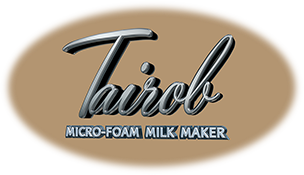Why cannot a coffee bar barista prepare milk like the MFMM does?
Steam frothing of milk is obtained by injecting steam to heat the milk while injecting air and some water into the milk. Both the temperature of the milk and the foam are important for a good result. Poor steam frothing may be caused by some reasons (by excess water in the milk, too much or too little milk fat content , the rate at which the barista can froth milk, his experience, milk that is not fresh or milk that was exposed to room temperature for many minutes, milk that was already steam frothed mixed with fresh milk.)
Is cappuccinolatte produced by the MFMM superior to a skilled barista?
The performance of the MFMM is similar or higher to the performance of a skilled barista; It is of absolute repeatability given standard ingredients. The uniform dispersion of the micro-foam milk within the cappuccino\latte and its sweet taste are unique. We’re not familiar so far with a barista with similar capability. The MFMM is of reduced size compared to existing coffee machine sizes, and likewise maintenance and cost are reduced. The MFMM raises the quality standard of cappuccino\latte anywhere and allows for new catering options for coffee services.
What types of milk could be used?
We have experience with the following: cow milk with 0% to 12% fat, goat milk, soy milk\drink, cow UHT milk.
Are there any restrictions using milk?
Yes. The milk should be fresh according to our definition. Fresh means that the milk prepared by the MFMM has a sweet taste and it has the special micro-foam form. According to our experience, milk that was left for several hours on the table at room temperature (summer) will fail. Milk with close expiration date will fail. “Fail” – means that after the preparation process is finished, the milk doesn’t become sweeter or its micro-foam structure is less dense or its consistency is reduced.
Could you define 'sweet' and structure of the 'micro-foam'?
It has been found through careful experimentation that liquids such as milk having a micro-foam structure re characterized by sweeter taste than otherwise, despite the absence of any sweeteners. This has decided benefits for drinks traditionally sweetened (such as coffee with milk), as a large segment of the drinking populace will seek the sweetened taste without sugar based sweeteners.
Milk micro-foam prepared according to our method is thick and dense in consistency; the air bubbles are invisibly small (for example being less than 10 microns in average diameter); and the remaining liquid (approx. 80% or less of the total volume) becomes uniform and homogenous. The volume of the ready prepared milk is approx. twice the volume of the milk prior to the whipping process; that volume could be controlled during the process. Actually, this liquid is stretched\enlarged by a whipping process; it probably seems as hosting miniature air bubbles surrendering the milk molecules or penetrating among them.
For how long is the micro-foam milk within the cappuccino remain steady?
According to milk, the micro-foam sits atop this liquid, not appreciably changing or aggregating for approx. 20 minutes; thereafter after one may observe the air bubbles reaching macroscopic dimensions and growing over time due to possible aggregation of several bubbles into one.
On the other hand, the sweet taste of your cappuccino due to the micro-foam milk inside remains steady even if the cappuccino is cooled or the micro-foam changes its appearance due to larger macroscopic air bubbles. We don’t have an explanation yet.
What do scientists say about the milk's micro-foam sweet taste?
Scientists studying the phenomenon of sweetening from micro-foam suggest that the proteins within the milk change their molecular form during the whipping process that is accompanied by a heat sequence, that return to the original form over time. Nowadays, there is lack of appropriate equipment to “see” into the molecules structure of the milk.
How does it work?
The new process incorporates air into the milk by whipping to an extreme fineness, introducing a consistent and unusually fine distribution of bubbles that improve and significantly sweeten the taste; that is what makes ordinary milk extraordinary.
The foam density is high when the micro-foam texture is observed through the entire volume of milk; the micro-foam becomes part of the milk, not just a layer of foam on top of the milk.
The milk preparation process uses pure milk only; viscosity varies from fluid to foam upon user. The performance of the automatic appliance is of absolute repeatability given standard ingredients.
The fully automatic whipping milk system produces properly textured foam at variable temperatures, it does not use high pressure steam (which reaches, commercial coffee machines, higher than 100 Celsius degrees = boiling the milk).
Why do you need computerized equipment to prepare milk?
There’re many types of cows living at different weather and locations.
Cattle are raised on diets primarily composed of grass or a concentrated diet of grain, soy, corn and other supplements resulting in various types of milk.
The milk pasteurizer equipment reduces the number of micro-organisms (pathogens) during the Heat Treatment. The milk pasteurization process and equipment is not unique.
As such, the milk that we use for preparing the micro-foam milk should be prepared accordingly; hence the process is not similar requiring a computer and sensors!
How much will it cost?
The cost for the home version of the MFMM will start at $470
The cost of the commercial version for small coffee bars (200 cups per day) will start at $1100
The cost for medium coffee bars (800 cups per day) will start at $1700
The cost for large coffee bars (2000 cups per day) will start at $2000


